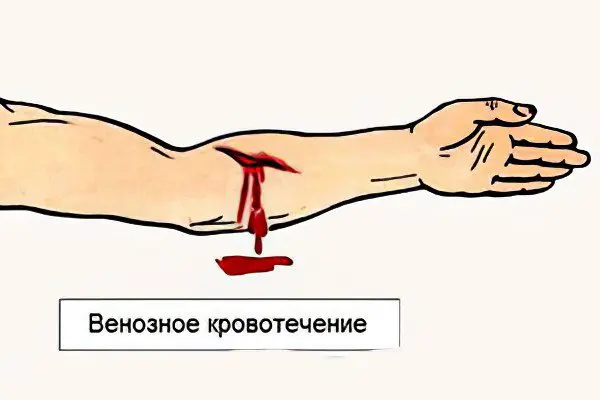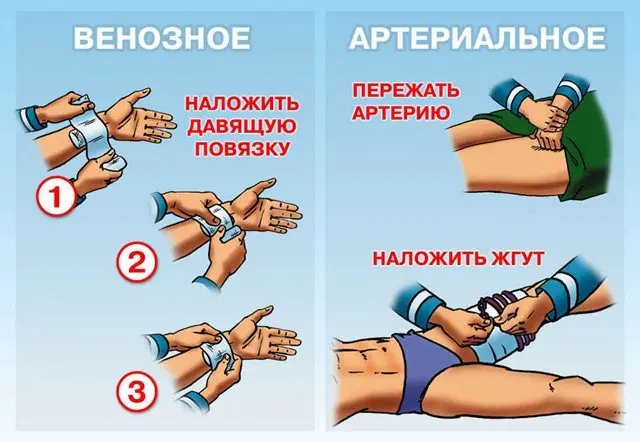Contents
Signs of venous bleeding
First aid for bleeding should be included in the basic knowledge of each person. No one is immune from the fact that bleeding will occur in loved ones or in a passerby on the street. During the time that an ambulance arrives, a person can lose a lot of blood, which will adversely affect his health, and with bleeding from deep veins, it is possible that the victim will die.
Venous bleeding can be of different localizations and the help varies. Allocate bleeding from:

Veins of the head and neck;
Superficial veins of the extremities;
Deep veins of the extremities.
The reasons for this condition are as follows:
Injuries and cuts;
Bleeding from varicose veins;
Diseases of the blood system;
Increasing pressure and others.
In order to properly provide emergency care, it is necessary to distinguish venous bleeding from arterial or capillary.
Signs of venous bleeding are:
Outflow from the wound of dark blood in a non-pulsating or weakly pulsating stream;
Massive blood loss;
Paleness, weakness, with a large blood loss – loss of consciousness;
Drop in blood pressure
Tachycardia (increased heart rate)
If the superficial veins of the hands and feet are damaged, unexpressed bleeding with dark blood is noted, which stops on its own after a few minutes. However, you should not hope for this and do not carry out first aid, since in this way minor damage to the deep veins may also appear. In addition, with high blood pressure, alcohol intoxication and blood diseases, the rate of thrombus formation slows down, and bleeding may increase.
It is also worth noting that deep veins are located on the inside of the limbs, therefore, when damage is localized in this area, it is better to immediately assume damage to them and take appropriate urgent measures.
How to stop venous bleeding?
For bleeding from superficial veins, wash the wound with hydrogen peroxide and apply a tight bandage. To do this, a sterile napkin is applied to the wound, a tight ball of cotton wool is applied to it and tightly bandaged in circular motions. After applying a tight bandage, be sure to consult a doctor. If the bandage is significantly saturated with blood and the bleeding does not stop, then damage to the deep veins should be assumed and a tourniquet should be applied.
Bleeding from the deep veins of the extremities, as well as the veins of the neck and head, requires urgent action, since in a short period of time a person will lose a sufficiently large volume of blood. Decreased blood volume can lead to shock, acute kidney failure, and other life-threatening conditions.
If deep vein bleeding is suspected:
Give the limb an elevated position;
Apply a tourniquet;
Apply an ice pack or a heating pad with cold water to the bleeding site;
Take the victim to the hospital as soon as possible.
If the veins of the neck are damaged, a problem arises in clamping the bleeding vessel, because it is quite natural that a tourniquet cannot be used. If there is a possibility of developing such a condition, the person should be taken to the hospital as soon as possible.
Emergency assistance includes the following activities:
The bleeding vessel must be pinched with fingers above and below the injury site, if possible pressing it against the bone base;
With a napkin soaked in hydrogen peroxide, tightly clamp the wound, thereby preventing air from entering the bloodstream and the development of an air embolism;
Apply cold to the bleeding site;
Urgently deliver the victim to the nearest hospital, where the vessel will be sutured.
In case of nosebleeds, a cotton swab moistened with hydrogen peroxide should be inserted into the nasal passage. Then press the wing of the nose to the bridge of the nose. To stop bleeding, do not tilt your head back, especially if the victim is unconscious. This will cause blood to drain down the back of the throat and may enter the respiratory tract. To completely stop bleeding from the nose, a heating pad with cold water should be applied to the bridge of the nose or the back of the head for 3 minutes, then take a break for 3 minutes. Repeat until the bleeding stops completely.
Applying a tourniquet for venous bleeding
The success of the measures taken and the recovery of the limb after the provision of medical assistance depend on the correct application of the tourniquet. The tourniquet can be applied for 1,5-2 hours in summer and 1-1,5 hours in winter. In addition, every hour in summer and every half hour in winter, it should be loosened for several minutes, while pressing the damaged vein to the bone to prevent the restoration of bleeding.

The rules for applying a tourniquet for venous bleeding are as follows:
Since venous blood flows from the distal to the proximal parts of the limb, the tourniquet is applied below the injury site as close to the wound as possible;
Clothing or a fabric lining should be applied to the skin so as not to injure soft tissues;
With vigorous movements, the tourniquet is stretched and wrapped around the limb;
The coils are located one after another, without pinching the skin between them;
Each subsequent turn should go a little on the previous one;
After two or three turns, the tension of the tourniquet can be somewhat loosened;
Attach a note to the limb indicating the time the tourniquet was applied, or write the time on the patient’s skin;
The tourniquet itself should not be covered with clothing, it is necessary that it immediately catches the eye.
The correct application of the tourniquet in case of damage to the veins is determined by the absence of bleeding, but the preservation of pulsation in the arteries (radial or foot arteries). The technique for providing emergency care for venous bleeding is quite simple. The main thing is not to get confused and do everything according to the algorithm. Emergency care largely determines the prognosis for the recovery and life of the patient, so everyone should master these skills.









